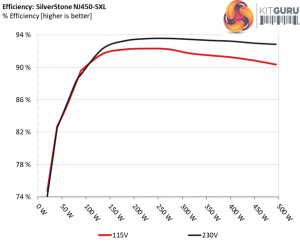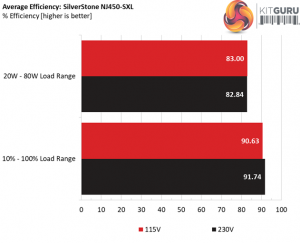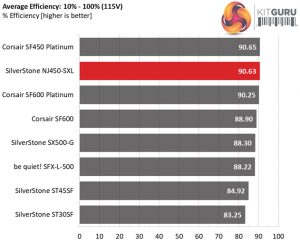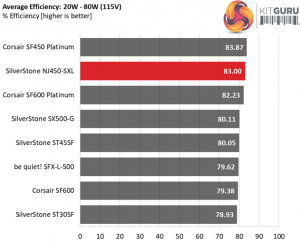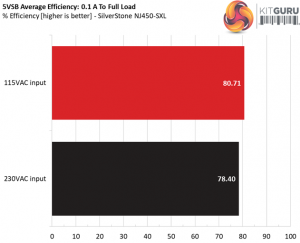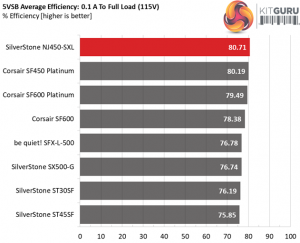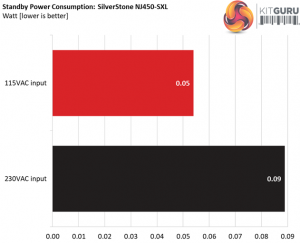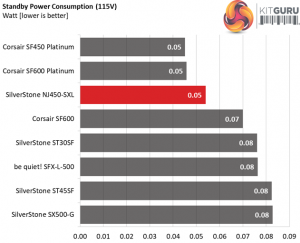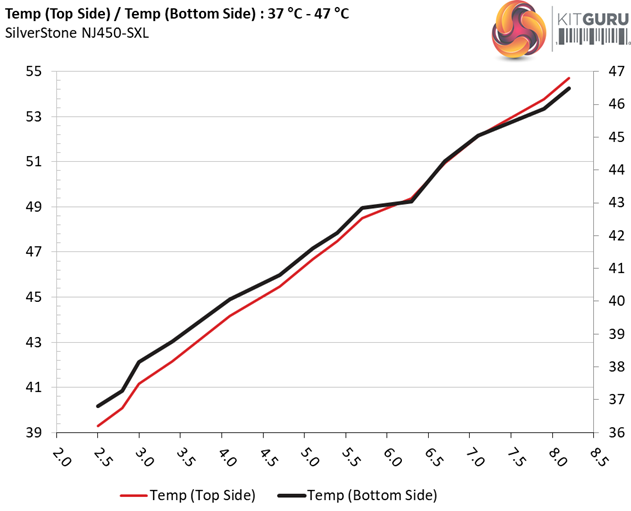Efficiency
Our efficiency testing procedure is detailed here.
Using results from the previous page, we plotted a chart showing the NJ450-SXL’s efficiency at low loads, and loads from 10 to 110 percent of its maximum-rated capacity.
This is a highly efficient platform. Only the Corsair SF450 Platinum manages to surpass it.
Efficiency At Low Loads
In the following tests, we measure the NJ450-SXL's efficiency at loads significantly lower than 10 percent of its maximum capacity (the lowest load the 80 PLUS standard measures). The loads we dial are 20, 40, 60, and 80W. This is important for representing when a PC is idle, with power-saving features turned on.
| Test # | 12V | 5V | 3.3V | 5VSB | DC/AC (Watts) | Efficiency | Fan Speed (RPM) | PSU Noise (dB[A]) | PF/AC Volts |
| 1 | 1.203A | 0.496A | 0.481A | 0.196A | 19.528 | 74.740% | 0 | <6.0 | 0.698 |
| 11.990V | 5.047V | 3.323V | 5.113V | 26.128 | 115.35V | ||||
| 2 | 2.474A | 0.992A | 0.994A | 0.392A | 39.964 | 82.488% | 0 | <6.0 | 0.861 |
| 11.989V | 5.044V | 3.320V | 5.104V | 48.448 | 115.33V | ||||
| 3 | 3.676A | 1.487A | 1.477A | 5.095A | 59.466 | 85.170% | 0 | <6.0 | 0.911 |
| 11.989V | 5.040V | 3.317V | 5.095V | 69.820 | 115.30V | ||||
| 4 | 4.938A | 1.987A | 1.991A | 0.786A | 79.836 | 89.606% | 0 | <6.0 | 0.934 |
| 11.995V | 5.037V | 3.314V | 5.086V | 89.097 | 115.28V |
The efficiency levels that this platform achieves under light loads is jaw dropping! Even with 20W load the NJ450-SXL achieves well over 70% efficiency.
5VSB Efficiency
The ATX specification (revision 1.4), along with CEC, ErP Lot 3 2014 and ErP Lot 6 2010/2013, states that the 5VSB standby supply efficiency should be as high as possible, recommending 75 percent or higher with 550mA, 1A, and 1.5A of load.
The supply should also achieve higher than 75% efficiency at 5VSB under full load, or with 3A if its max current output on this rail is higher than 3A.
We take six measurements: one each at 100, 250, 550, 1000, and 1500mA, and one with the full load the 5VSB rail can handle.
| Test # | 5VSB | DC/AC (Watts) |
Efficiency | PF/AC Volts |
| 1 | 0.100A | 0.512 | 76.877% | 0.037 |
| 5.118V | 0.666 | 115.37V | ||
| 2 | 0.250A | 1.279 | 81.155% | 0.086 |
| 5.113V | 1.576 | 115.37V | ||
| 3 | 0.550A | 2.808 | 82.588% | 0.171 |
| 5.104V | 3.400 | 115.38V | ||
| 4 | 1.000A | 5.092 | 82.729% | 0.263 |
| 5.091V | 6.155 | 115.36V | ||
| 5 | 1.500A | 7.616 | 82.819% | 0.327 |
| 5.076V | 9.196 | 115.38V | ||
| 6 | 2.501A | 12.619 | 82.091% | 0.395 |
| 5.046V | 15.372 | 115.36V |
This is one of the most efficient 5VSB rails that we have seen so far.
Power Consumption In Idle And Standby
In the table below, you'll find the power consumption and voltage values of all rails (except -12V) when the PSU is idle (powered on, but without any load on its rails), and the power consumption when the unit is in standby mode (without any load, at 5VSB).
| Mode | 12V | 5V | 3.3V | 5VSB | Watts | PF/AC Volts |
| Idle | 11.986V | 5.049V | 3.326V | 5.121V | 2.634 | 0.094 |
| 115.4V | ||||||
| Standby | 0.054 | 0.003 | ||||
| 115.4V | ||||||
The amount of energy, called vampire of phantom power, that the supply consumes in standby, is very low.
Delta Temperature
Our mixed noise testing is described in detail here.
The following chart illustrates the delta between the PSU's top and the bottom sides/heatsinks. The results were obtained at 37°C (98.6°F) to 47°C (116.6°F) ambient temperature.
 KitGuru KitGuru.net – Tech News | Hardware News | Hardware Reviews | IOS | Mobile | Gaming | Graphics Cards
KitGuru KitGuru.net – Tech News | Hardware News | Hardware Reviews | IOS | Mobile | Gaming | Graphics Cards


